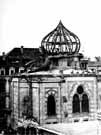
|
|
|

|

|

|

|
|
Click on an image to see a larger, more detailed picture.
|
|
|
|
|
| 1943: Death and Resistance |

|
pg. 480 |

|
|
|
|
| |
 Enjoying a reprieve from work, a platoon of forced-labor workers gathers for a photograph. Although mostly garbed in civilian clothing, these members of an Hungarian labor battalion all wear military caps. While Heinrich Himmler and the SS sought to kill all of Europe's Jews, Albert Speer, as head of the German war economy, maneuvered to secure as many workers as possible to rebuild factories and produce desperately needed war materiel.
Enjoying a reprieve from work, a platoon of forced-labor workers gathers for a photograph. Although mostly garbed in civilian clothing, these members of an Hungarian labor battalion all wear military caps. While Heinrich Himmler and the SS sought to kill all of Europe's Jews, Albert Speer, as head of the German war economy, maneuvered to secure as many workers as possible to rebuild factories and produce desperately needed war materiel.
Photo: Yad Vashem
|
 The demolition of this Luxembourg synagogue was completed in the fall of 1943 after a two-year delay. The order to destroy the Jewish house of worship was issued in May 1941. No local contractor was willing to do the job, so the Nazis hired two Italians to complete the task. Approximately 3500 Jews lived in Luxembourg at the beginning of World War II. The tiny nation was declared judenrein (cleansed of Jews) after the last Jewish transport left the country on September 28, 1943.
The demolition of this Luxembourg synagogue was completed in the fall of 1943 after a two-year delay. The order to destroy the Jewish house of worship was issued in May 1941. No local contractor was willing to do the job, so the Nazis hired two Italians to complete the task. Approximately 3500 Jews lived in Luxembourg at the beginning of World War II. The tiny nation was declared judenrein (cleansed of Jews) after the last Jewish transport left the country on September 28, 1943.
Photo: Archives Nationales de la Grand-Duche de Luxembourg / United States Holocaust Memorial Museum Photo Archive
|
 Abba Kovner
Abba Kovner
In 1941 23-year-old artist Abba Kovner was one of the leaders of Ha-Shomer ha-Tsa'ir, a Socialist Zionist youth organization, in Vilna, Lithuania. As the Nazis increased their roundups of Jews, Kovner and others hid in a Dominican convent. When he learned of the killings in the Ponary Forest, Kovner realized the full scope of the Nazi plan--and vowed to fight back. On January 1, 1942, Kovner warned his people that deportation meant death. He issued a stirring call to Jewish youth to flee and fight, not "to go as sheep to the slaughter." Kovner helped organize a united partisan resistance, and with the death of Yitzhak Wittenberg, he became the commander of the United Partisan Organization (FPO). As the Nazis emptied the Vilna Ghetto of its last Jews in September 1943, Kovner led the escape of his fighters into the Rudninkai Forest, where, as the "Avenger" battalion, they fought on. Kovner lived until 1988.
Photo: YIVO Institute for Jewish Resesarch / United States Holocaust Memorial Museum Photo Archive
|
|

|

|

|

|
 September 16, 1943: More than 37,000 Italian Jews come under German rule.
September 16, 1943: More than 37,000 Italian Jews come under German rule.
|
 September 18, 1943: Two thousand Jews in Minsk, Belorussia, are deported to the Sobibór death camp; 80 are selected for forced labor and the rest are gassed.
September 18, 1943: Two thousand Jews in Minsk, Belorussia, are deported to the Sobibór death camp; 80 are selected for forced labor and the rest are gassed.
|
 September 18-19, 1943: The Jews of Lida, Belorussia, are deported to the Majdanek death camp.
September 18-19, 1943: The Jews of Lida, Belorussia, are deported to the Majdanek death camp.
|
 September 20, 1943: One thousand Jewish inmates of the camp at Szebnie, Poland, are trucked to a nearby field and executed with machine guns. The bodies are burned and the bones thrown into the Jasiolka River.
September 20, 1943: One thousand Jewish inmates of the camp at Szebnie, Poland, are trucked to a nearby field and executed with machine guns. The bodies are burned and the bones thrown into the Jasiolka River.
|
|
|
|
|
| 1943: Death and Resistance |

|
pg. 480 |

|
|
The Holocaust Chronicle
© 2009 Publications International, Ltd.
|
|
